
Wine Culture and Information since 2002 - Volume 22
 Wine Culture and Information since 2002 - Volume 22 |
|
Issue 192, February 2020 |
Contents |
|
|
USA and European Union: a Clash Between Wine, Taxes and Tariffs |
|
The introduction of tariffs by the United States of America on European Union products – news being in the limelight for several weeks now – is producing the first effects and unfortunately they are not positive. The consequences of this measure are beginning to produce the first tangible effects and, understandably, trade associations and institutions are trying to take precautionary measures in order to limit their impact. Everyone agrees the consequences of tariffs will be evident and substantial, of course, this will also have an impact in the world of wine. In fact, in some European countries, the first effects on the economy of the sectors affected by this measure, which are evidently negative, begin to produce their impact. In particular, France is already complaining of a double-digit drop in wine exports to the United States of America. The first European countries to suffer the consequences of the introduction of this protectionist measure are France and Spain. These two countries, in fact, have announced they have recorded significant decreases in the export share to the United States of America. France, at the end of November 2019, recorded a decrease of -36% compared to the same period of 2018 while Spain announced the loss can be determined with a drop of -9.2%. In both cases, this loss is believed to be largely determined by the decision to introduce tariffs by the US and which led to a significant drop in exports after five years. To take advantage of this result, even marking an increase in exports to the United States of America, are Italy and New Zealand, respectively with increases of +9.7% and +8.8%. The determination of the drop due to the effects of the tariffs seems to be possible if we consider the percentage imposed on French and Spanish products. If it is true France and Spain seem to have suffered a heavy loss and, at the same time, Italy would have good reasons to rejoice for the consequent increase in exports – due to a lower percentage of tariffs – in reality, no one in Europe has really good reasons to be happy for. In fact, most producers fear that in the coming months the effects of the tariffs will be even more evident for everyone, including Italy. The Italian wine sector, fearing a rather important impact in the coming months, are seeking the political support of the Government, inviting Italian politicians to take action in the appropriate European Union offices in order to promote proper measures capable of limiting the expected losses. It definitely is a difficult task and, evidently, it is not only in the interest of Italy as all the member countries of the European Union are trying to understandably do the same. An obviously complex and difficult undertaking, by also considering – above all – the reasons that led the United States of America to introduce tariffs on European production. At institutional and bureaucratic level, in fact, something is moving, as even the American trade associations understand the economic consequences caused by the tariffs. The Comité Européen des Entreprises Vins (Ceev) and the American Wine Institute have in fact entered into a union of intent with the aim of asking their respective governments to the bilateral revocation of tariffs on wine, as required by the GATT (General Agreement on Tariffs and Trade). The clear demonstration the provision of tariffs imposed by the USA raises many concerns for all the figures and associations depending on wine market, both in Europe and in the United States of America. Furthermore, the mutual concern is also the fear for the most direct consequence determined by the lack of profit, that is the concrete risk of job losses and, not least, the unavoidable increase of wine prices in the US market. On both sides – the European Union and the United States of America – there is a clear conviction of the need for free trade in order to favor the respective wine production to be present in the markets of others. It is not difficult, in fact, to think the introduction of tariffs by the US government will cause a similar response from the European Union. A scenario far away from the times we are living and which increasingly sees the world as a global and unique market, in which the expression of local products can be appreciated elsewhere, while maintaining – each of them – its own identity and peculiarities. The result is the defeat of all because if the sale of European wine is hindered in the United States of America, the American one will likewise be hindered with similar measures in the European market. At the end everyone will lose, everyone will be poorer and not only in economic terms but, above all, in terms of sharing and cultural growth. France, the country that suffered the worst consequences of the introduction of US tariffs, did not stand by and moved to the counterattack. The French government, in fact, which was expecting the application of high tariffs on its products, has responded by introducing the so-called digital tax against the American giants of the web. This measure has forced the American government to deal with the French one, and it seems they reached a “truce” and which, apparently, will continue throughout 2020. It certainly does not end here and it is too easy to imagine – by considering what the two opposite sides of the Atlantic ocean are doing – that other measures will be adopted in order to limit the marketing opportunities of the respective productions. As for European wine and commercial relations with other countries, it does not end here as – it seems so – the brexit is about to be implemented with consequences that are still not entirely clear. This, of course, will lead to new clashes between institutions and bureaucracy, with the result the world will suddenly seem to us more closed, smaller and more fragile. Antonello Biancalana
|
||||
Contrasts of Siracusa Moscato Passito and Breganze TorcolatoSweet wines from dried grapes have always been among the most sought after and prized ones in the history of wine, divine nectars of amazing sensorial complexity |
|
Sweet wines undeniably represent a fundamental page in the history of wine and, in many respects, it can be said the prestige of quality wine making of past centuries is mainly represented by these wines. According to what we know and reached our present days regarding the production of wines at the dawn of civilization, suggests the taste at those times was decidedly distant from ours. This does not depend only on the taste of past times, but also on the evolution and development of wine making practices and, no less important, the methods of keeping. It is supposed, in fact, the wines of ancient Greece were not only sweet, but most likely characterized by rather high quantities of volatile acidity. In other words, the wines of those times – and not only in Greece – were likely to have a scent and flavor in which it was possible to recognize vinegar. Times have obviously changed, wine technology has evolved quickly, including taste, and men, in the course of centuries, have learned how to control certain faults in wine, including preventing the development of the typical qualities of vinegar. The fact in the famous symposiums of ancient Greece the wine was consumed after dilution with water, could make one think of wines with strong aromas and flavors, very dense, not suitable to be consumed pure. Sweet wines from dried grapes have however stood to the changes of time and still today keep the prestige of past times, destined for a “niche market”, often represent the wine making excellence of many producers. The tasting by contrast of this month compares two famous and ancient sweet wines made from dried grapes and produced in Italy: Siracusa Moscato Passito and Breganze Torcolato, two wines full of charm and history, distant and not only for geographical reasons. The only common feature in these two wines is in fact the use of dried white berried grapes, then transformed into wine.
|
|
Siracusa, the ancient Sicilian city, owes its ancient reputation as a land of wine to one of the oldest grapes known and which – since the dawn of enology – is considered among the most elegant and appreciated varieties: Muscat Blanc. It is believed this variety was introduced in these lands by the ancient Phoenician colonists and that, precisely in Siracusa, it found a favorable environment which lead to the birth of one of the most valuable and well-known wines of the ancient era. Siracusa Moscato Passito, in fact, is considered the oldest wine in Italy and, in ancient times, was known by the name of Pollio or Biblino. The first name derives from Pollis, legendary tyrant of Siracusa, while the second originates from the ancient and homonymous wine that was presumably produced in the Phoenician city of Biblo, on the coast of Lebanon, called by the Greeks Byblos and today known as Jbeil. It is believed the ancient wine Biblino was introduced to Siracusa by the Phoenicians, some speculate instead it was brought by the legendary tyrant Pollis and that, in his honor, the wine took the name of Pollio. The fame and quality of this wine was such they started its production in Siracusa by using the ancient Muscat Blanc grape – the same used for the ancient Biblino – and then acquired, in later times, its own dignity and identity, taking the name of “Moscato di Siracusa”. This excellent Sicilian wine, according to the production disciplinary, provides for a minimum quota of 85% of Muscat Blanc, while the remaining part can be represented from white berried grapes allowed in Sicily. The production obviously requires the preliminary drying of the grapes, a practice that can be carried out, according to the disciplinary, both on the plant and after harvesting. As for the choice of grapes to be used for the production of Siracusa Moscato Passito, it should be noted that – despite the disciplinary allows the use of different varieties – the majority of producers prefer using Muscat Blanc only.
|
||||
|
Breganze Torcolato certainly is one of the prestigious wine making excellence of Veneto. This precious wine is produced in Breganze, a town in the province of Vicenza, with Vespaiola grape, a white berried variety that we almost exclusively find in this area. The origin of the name is evidently linked to vespa (Italian for wasp) which seems to be particularly attracted to this grape because of its aromas and its very sweet juice. The name of the wine – Torcolato – derives from the traditional system with which Vespaiola bunches are dried, that is “torcolati”, meaning “to twist”. This practice consists of twisting and tying the bunches together with a string, then hung on the beams in order to allow the drying. This technique is still used today by the producers, however the drying of the grapes is also carried out by placing the bunches in boxes, then left in the air in order to favor the loss of water and the concentration of the juice. The production of sweet wines in the Breganze area has a history long of centuries, particularly appreciated on the tables of the wealthiest classes, especially in those of Venice. About the fame and quality of sweet wines of Breganze we find written evidence from the 1600s, mentioned, in particular, by Andrea Scoto in his Itinerario (Itinerary) published in 1610. The sweet wines of Breganze are also mentioned in “Il Roccolo Ditirambo” (The Roccolo Dithyramb), written by Aureliano Acanti in 1754, in which he praises a wine made with “grapes hung in the air” and which he defines as very sweet Pasquale and which after three years becomes exquisite. Even today Torcolato wine is allowed to age in cask, a procedure which may also lasts for three years in order to get a wine with an enchanting amber gold color and with complex and elegant aromas. The production disciplinary provides for the minimum use of 85% of Vespaiola and the remaining part is made of grapes allowed in the province of Vicenza. In this regard, it should be noted the producers of Breganze Torcolato often tend to use Vespaiola grape only and, in some cases, the aging in wood can also last for five years.
|
Before starting the tasting by contrast of this month, we will choose the wines we will pour into our glasses. They certainly are rare and precious wines, which production is perpetuated by the producers of the respective territories, however the choice should not present particular difficulties, also thanks to the general homogeneity with which these nectars are produced. In both wines we will make sure they are produced with the dominant varieties alone, that is Muscat Blanc for Siracusa Moscato Passito and Vespaiola for Breganze Torcolato. As for the method of production, in particular aging, the wine from Veneto is aged in cask, including the barrique, while the Sicilian wine is usually aged in steel tanks. This technical characteristic introduces, in fact, a further difference between the two wines, however the organoleptic power they express limits, in part, the effect of aging in different containers. The two wines are poured into their respective tasting glasses at a temperature of 15 °C. (59 °F) The first sensorial characteristic we are going to evaluate in the two wines of our tasting by contrast is appearance, that is the analysis of the color and transparency observed from the glass. The first wine we take into consideration is Siracusa Mostato Passito and, by tilting the glass over a white surface – for example a white sheet – we observe the base of the wine in order to appreciate the color. At the sight, the Sicilian wine shows a dark and intense golden yellow color, frequently amber, with a transparency that allows the vision of the object placed in contrast between the glass and the white surface. Let's now evaluate the nuance of Siracusa Moscato Passito, by looking at the edge of the wine, towards the opening of the glass: also in this case we note a golden yellow color. Let's move on to the evaluation of the appearance of Breganze Torcolato, by keeping the glass tilted over the white surface. The difference with Sicilian wine seems minimal as, also in this case, a golden yellow color tending to amber hue and a good transparency are clearly evident. The same color is also confirmed in the nuance, observed at the edge of the glass, towards the opening. The most exciting part of the evaluation of sweet wines from dried grapes is certainly the olfactory analysis, that is, the examination of perfumes that are perceived from the glass and given by the grapes, the wine making technique and, no less important, by time. In fact, in sweet wines produced with dried grapes, there are many factors determining the olfactory profile and not only deriving from the specific characteristics of the grape, as the processes of aging, oxidation and reduction give these wines, over time, sensorial peaks of remarkable elegance and unrepeatable emotion. These wines are dominated by the finest aromas of dried fruit and jam, with complex and elegant nuances impossible to perceive in any other style of wine. The production technique, in particular, the container used for fermentation and aging – inert tanks or wooden barrels – further shape the olfactory profile of these wines. If these qualities can make us think of wines that, in general terms, all tend to resemble each other in the glass, in reality this is a completely wrong assumption, as each of these wines is identified with magnificent and absolutely unique organoleptic expressions. Let's proceed with the evaluation of the olfactory profiles of the two wines and begin with the examination of the aromas expressed by the glass of Siracusa Moscato Passito. By holding the glass of the Sicilian wine in vertical position and, without swirling it, proceed with the first smell in order to evaluate its opening. Siracusa Moscato Passito gives to our nose intense, clean and pleasant aromas of raisins, dried apricots and dried figs, as well as candied orange and orange blossom. Let's swirl the glass, an operation favoring the development of aromas, then do a new smell. The olfactory profile of Siracusa Moscato Passito is completed with honey, peach jam, date as well as pleasant hints reminiscent of sage, lavender and jasmine. Let's now pass to the evaluation of the opening of Breganze Torcolato, holding the glass in vertical position and without swirling it. In the wine from Veneto can be appreciated intense and pleasing aromas of raisins, apricots and honey. Furthermore, in the opening can be perceived the contribution of the aging in wood expressed by the sensation of vanilla. After having swirled the glass, the olfactory profile of Breganze Torcolato is completed with aromas of candied fruit, quince jam, pear jam, date, dried fig and honey. Let's now move on to the evaluation of the gustatory profiles of Siracusa Moscato Passito and Breganze Torcolato, starting from the Sicilian wine. Let's take a sip of this wine and evaluate the attack, that is the initial sensations perceived in the mouth. Siracusa Moscato Passito is characterized by an attack in which both sweetness and roundness dominate, sensations that have a perfect balance with the pleasing crispness given by acidity. The effect of alcohol contributes to the roundness of the wine, its burning effect is perceptible however in harmony with the gustatory profile of the wine. In the mouth we perceive, clear and intense, flavors of raisins, apricots and candied orange. Let's now pass to the evaluation of Breganze Torcolato and take a sip of this wine in order to evaluate its attack. In the mouth is perceived, just like in the Sicilian wine, a clear and pleasing sweetness as well as roundness, also in this case perfectly balanced by acidity. The sensation of roundness and structure is superior to Siracusa Moscato Passito and in the mouth we perceive flavors of raisins, apricots and honey. The tasting by contrast of this month ends with the evaluation of the final sensations the wines leave in the mouth. In particular, we are going to evaluate the taste-olfactory persistence, that is the time during which the gustatory characteristics continue to be perceived in the mouth after swallowing. The finish of Siracusa Moscato Passito expresses a good persistence and in the mouth we can perceive both the sensations of sweetness and roundness, as well as the crispness of acidity. We also perceive the flavors of raisins, apricots and candied citrus peel, clean and intense. The finish of Breganze Torcolato is characterized by a good taste-olfactory persistence, in which both sweetness and roundness are still perceived, properly balanced by acidity, as well as a sensation of superior structure compared to Sicilian wine. In the mouth we can perceive, also in this case intense and clean, the flavors of raisins, apricots, honey and dried figs.
|
||||||||
Wines of the Month |
|
|
|
Score legend Prices are to be considered as indicative. Prices may vary according to the country or the shop where wines are bought |
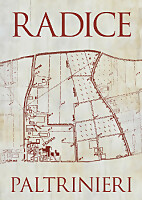
|
|
Lambrusco di Sorbara Radice 2018 |
|
| Paltrinieri (Emilia-Romagna, Italy) | |
 Lambrusco di Sorbara Lambrusco di Sorbara | |
| Price: € 10.00 | Score: |
 Pale cherry pink and nuances of pale pink, transparent, fine and
persistent perlage. Pale cherry pink and nuances of pale pink, transparent, fine and
persistent perlage.
 Intense, clean, pleasing and refined, starts with hints of cherry,
raspberry and apple followed by aromas of strawberry, cyclamen, pink
grapefruit, plum, rose and peach. Intense, clean, pleasing and refined, starts with hints of cherry,
raspberry and apple followed by aromas of strawberry, cyclamen, pink
grapefruit, plum, rose and peach.
 Effervescent and crisp attack, however balanced by alcohol, good body,
intense flavors, agreeable. Effervescent and crisp attack, however balanced by alcohol, good body,
intense flavors, agreeable.
 Persistent finish with flavors of cherry, raspberry and pink
grapefruit. Persistent finish with flavors of cherry, raspberry and pink
grapefruit.
 Refermented in bottle. Refermented in bottle. |
|
 Aperitifs, Risotto with vegetables and fish, Fried fish, Cold cuts, Dairy products Aperitifs, Risotto with vegetables and fish, Fried fish, Cold cuts, Dairy products |
|
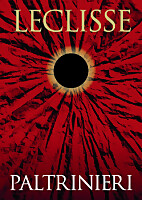
|
|
Lambrusco di Sorbara Leclisse 2018 |
|
| Paltrinieri (Emilia-Romagna, Italy) | |
 Lambrusco di Sorbara Lambrusco di Sorbara | |
| Price: € 10.00 | Score: |
 Brilliant cherry pink and nuances of cherry pink, transparent, fine and
persistent perlage. Brilliant cherry pink and nuances of cherry pink, transparent, fine and
persistent perlage.
 Intense, clean, pleasing and refined, starts with hints of cherry,
strawberry and raspberry followed by aromas of cyclamen, blueberry, rose,
peach, apple and plum. Intense, clean, pleasing and refined, starts with hints of cherry,
strawberry and raspberry followed by aromas of cyclamen, blueberry, rose,
peach, apple and plum.
 Effervescent and crisp attack, however balanced by alcohol, good body,
intense flavors, agreeable. Effervescent and crisp attack, however balanced by alcohol, good body,
intense flavors, agreeable.
 Persistent finish with flavors of cherry, ,strawberry and raspberry. Persistent finish with flavors of cherry, ,strawberry and raspberry. Produced with the Martinotti method. Produced with the Martinotti method. |
|
 Meat appetizers, Cold cuts, Pasta with meat and fish, Fried fish Meat appetizers, Cold cuts, Pasta with meat and fish, Fried fish |
|
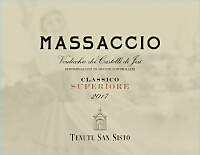
|
|
Verdicchio dei Castelli di Jesi Classico Superiore Massaccio Tenute San Sisto 2017 |
|
| Fazi Battaglia (Marches, Italy) | |
 Verdicchio Verdicchio | |
| Price: € 15.00 | Score: |
 Brilliant straw yellow and nuances of straw yellow, very transparent. Brilliant straw yellow and nuances of straw yellow, very transparent. Intense, clean, pleasing and refined, starts with hints of apple, plum
and hawthorn followed by aromas of pear, citrus fruits, honey, broom,
anise, saffron and almond. Intense, clean, pleasing and refined, starts with hints of apple, plum
and hawthorn followed by aromas of pear, citrus fruits, honey, broom,
anise, saffron and almond.
 Crisp attack and however balanced by alcohol, good body, intense
flavors, agreeable. Crisp attack and however balanced by alcohol, good body, intense
flavors, agreeable.
 Persistent finish with flavors of apple, plum and almond. Persistent finish with flavors of apple, plum and almond. 6 months in cement tanks, at least 8 months in bottle. 6 months in cement tanks, at least 8 months in bottle. |
|
 Pasta with mushrooms, Stewed fish, Roasted white meat, Mushroom soups Pasta with mushrooms, Stewed fish, Roasted white meat, Mushroom soups |
|
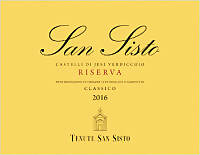
|
|
Castelli di Jesi Verdicchio Rserva Classico San Sisto 2016 |
|
| Fazi Battaglia (Marches, Italy) | |
 Verdicchio Verdicchio | |
| Price: € 18.90 | Score: |
 Brilliant golden yellow and nuances of straw yellow, very transparent. Brilliant golden yellow and nuances of straw yellow, very transparent. Intense, clean, pleasing, refined and elegant, starts with hints of
apple, plum and citrus fruits followed by aromas of hawthorn, pineapple,
broom, honey, butter, almond, mineral and vanilla. Intense, clean, pleasing, refined and elegant, starts with hints of
apple, plum and citrus fruits followed by aromas of hawthorn, pineapple,
broom, honey, butter, almond, mineral and vanilla.
 Crisp attack and however balanced by alcohol, good body, intense
flavors, pleasing roundness. Crisp attack and however balanced by alcohol, good body, intense
flavors, pleasing roundness.
 Persistent finish with flavors of apple, plum and almond. Persistent finish with flavors of apple, plum and almond. Fermented in cask, 10 months in cask. Fermented in cask, 10 months in cask. |
|
 Stuffed pasta with mushrooms, Roasted white meat, Roasted fish, Mushroom soups Stuffed pasta with mushrooms, Roasted white meat, Roasted fish, Mushroom soups |
|
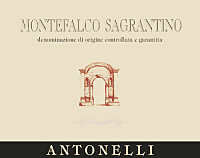
|
|
Montefalco Sagrantino 2014 |
|
| Antonelli San Marco (Umbria, Italy) | |
 Sagrantino Sagrantino | |
| Price: € 21.00 | Score: |
 Deep ruby red and nuances of garnet red, little transparent. Deep ruby red and nuances of garnet red, little transparent. Intense, clean, pleasing, refined and elegant, starts with hints of
blackberry, black cherry and violet followed by aromas of plum, blueberry,
peony, tamarind, chocolate, tobacco, cinnamon, mace, leather, vanilla and
menthol. Intense, clean, pleasing, refined and elegant, starts with hints of
blackberry, black cherry and violet followed by aromas of plum, blueberry,
peony, tamarind, chocolate, tobacco, cinnamon, mace, leather, vanilla and
menthol.
 Tannic attack and however balanced by alcohol, full body, intense
flavors, agreeable. Tannic attack and however balanced by alcohol, full body, intense
flavors, agreeable.
 Persistent finish with flavors of blackberry, plum and black cherry. Persistent finish with flavors of blackberry, plum and black cherry. 24 months in cask, 12 months in cement tanks, 12 months in bottle. 24 months in cask, 12 months in cement tanks, 12 months in bottle. |
|
 Game, Roasted meat, Stewed and braised meat, Hard cheese Game, Roasted meat, Stewed and braised meat, Hard cheese |
|
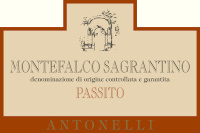
|
|
Montefalco Sagrantino Passito 2012 |
|
| Antonelli San Marco (Umbria, Italy) | |
 Sagrantino Sagrantino | |
| Price: € 21.00 - 375ml | Score: |
 Deep ruby red and nuances of garnet red, little transparency. Deep ruby red and nuances of garnet red, little transparency. Intense, clean, pleasing, refined and elegant, starts with hints of
blackberry, black cherry and dried violet followed by aromas of plum,
blueberry, chocolate, tobacco, pink pepper, walnut husk, cinnamon, mace,
vanilla, menthol and nail polish. Intense, clean, pleasing, refined and elegant, starts with hints of
blackberry, black cherry and dried violet followed by aromas of plum,
blueberry, chocolate, tobacco, pink pepper, walnut husk, cinnamon, mace,
vanilla, menthol and nail polish.
 Sweet and tannic attack, however balanced by alcohol, full body,
intense flavors, pleasing roundness. Sweet and tannic attack, however balanced by alcohol, full body,
intense flavors, pleasing roundness.
 Persistent finish with flavors of blackberry, plum and black cherry. Persistent finish with flavors of blackberry, plum and black cherry. 12 months in cask, 18 months in cement tanks, 12 months in bottle. 12 months in cask, 18 months in cement tanks, 12 months in bottle. |
|
 Fruit desserts, Chocolate tarts, Confectionery, Hard cheese Fruit desserts, Chocolate tarts, Confectionery, Hard cheese |
|
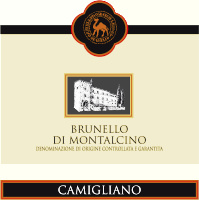
|
|
Brunello di Montalcino 2014 |
|
| Camigliano (Tuscany, Italy) | |
 Sangiovese Grosso Sangiovese Grosso | |
| Price: € 30.00 | Score: |
 Brilliant ruby red and nuances of garnet red, moderate transparency. Brilliant ruby red and nuances of garnet red, moderate transparency. Intense, clean, pleasing and refined, starts with hints of black
cherry, plum and violet followed by aromas of raspberry, blueberry, dried
rose, tobacco, chocolate, vanilla and menthol. Intense, clean, pleasing and refined, starts with hints of black
cherry, plum and violet followed by aromas of raspberry, blueberry, dried
rose, tobacco, chocolate, vanilla and menthol.
 Tannic attack and however balanced by alcohol, full body, intense
flavors, pleasing crispness. Tannic attack and however balanced by alcohol, full body, intense
flavors, pleasing crispness.
 Persistent finish with flavors of black cherry, plum and raspberry. Persistent finish with flavors of black cherry, plum and raspberry. 224 months in cask. 224 months in cask. |
|
 Game, Roasted meat, Stewed and braised meat, Hard cheese Game, Roasted meat, Stewed and braised meat, Hard cheese |
|
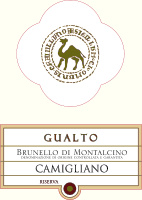
|
|
Brunello di Montalcino Riserva Gualto 2013 |
|
| Camigliano (Tuscany, Italy) | |
 Sangiovese Grosso Sangiovese Grosso | |
| Price: € 60.00 | Score: |
 Brilliant ruby red and nuances of garnet red, little transparency. Brilliant ruby red and nuances of garnet red, little transparency. Intense, clean, pleasing, refined and elegant, starts with hints of
plum, black cherry and dried violet followed by aromas of blueberry,
raspberry, dried rose, leather, cocoa, tobacco, cinnamon, licorice, mace,
vanilla and menthol. Intense, clean, pleasing, refined and elegant, starts with hints of
plum, black cherry and dried violet followed by aromas of blueberry,
raspberry, dried rose, leather, cocoa, tobacco, cinnamon, licorice, mace,
vanilla and menthol.
 Tannic attack and however balanced by alcohol, full body, intense
flavors, pleasing crispness. Tannic attack and however balanced by alcohol, full body, intense
flavors, pleasing crispness.
 Persistent finish with flavors of plum, black cherry and raspberry. Persistent finish with flavors of plum, black cherry and raspberry. 36 months in cask. 36 months in cask. |
|
 Game, Roasted meat, Stewed and braised meat, Hard cheese Game, Roasted meat, Stewed and braised meat, Hard cheese |
|
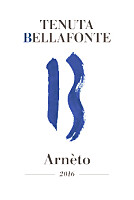
|
|
Arneto 2016 |
|
| Tenuta Bellafonte (Umbria, Italy) | |
 Trebbiano Spoletino Trebbiano Spoletino | |
| Price: € 20.00 | Score: |
 Deep golden yellow and nuances of golden yellow, very transparent. Deep golden yellow and nuances of golden yellow, very transparent. Intense, clean, pleasing, refined and elegant, starts with hints of
quince, medlar and citrus fruits followed by aromas of peach, hawthorn,
mango, lychee, lily, broom, butter, oregano, mineral and hints of vanilla. Intense, clean, pleasing, refined and elegant, starts with hints of
quince, medlar and citrus fruits followed by aromas of peach, hawthorn,
mango, lychee, lily, broom, butter, oregano, mineral and hints of vanilla.
 Crisp attack and however balanced by alcohol, good body, intense
flavors, pleasing roundness. Crisp attack and however balanced by alcohol, good body, intense
flavors, pleasing roundness.
 Persistent finish with flavors of quince, medlar and mango. Persistent finish with flavors of quince, medlar and mango. 6 months in cask, at least 5 months in bottle. 6 months in cask, at least 5 months in bottle. |
|
 Stuffed pasta with mushrooms, Stewed white meat, Stewed fish, Mushroom soups Stuffed pasta with mushrooms, Stewed white meat, Stewed fish, Mushroom soups |
|

|
|
Montefalco Sagrantino Collenottolo 2013 |
|
| Tenuta Bellafonte (Umbria, Italy) | |
 Sagrantino Sagrantino | |
| Price: € 35.00 | Score: |
 Intense ruby red and nuances of garnet red, little transparency. Intense ruby red and nuances of garnet red, little transparency. Intense, clean, pleasing, refined and elegant, starts with hints of
blackberry, plum and dried violet followed by aromas of black cherry,
blueberry, tobacco, cocoa, cinnamon, leather, licorice, pink pepper,
vanilla and menthol. Intense, clean, pleasing, refined and elegant, starts with hints of
blackberry, plum and dried violet followed by aromas of black cherry,
blueberry, tobacco, cocoa, cinnamon, leather, licorice, pink pepper,
vanilla and menthol.
 Tannic attack and however balanced by alcohol, full body, intense
flavors, pleasing roundness. Tannic attack and however balanced by alcohol, full body, intense
flavors, pleasing roundness.
 Persistent finish with flavors of blackberry, plum and black cherry. Persistent finish with flavors of blackberry, plum and black cherry. 36 months in cask, 12 moths in bottle. 36 months in cask, 12 moths in bottle. |
|
 Game, Roasted meat, Stewed and braised meat, Hard cheese Game, Roasted meat, Stewed and braised meat, Hard cheese |
|
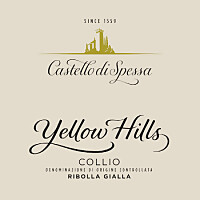
|
|
Collio Ribolla Gialla Yellow Hills 2018 |
|
| Castello di Spessa (Friuli-Venezia Giulia, Italy) | |
 Ribolla Gialla Ribolla Gialla | |
| Price: € 16.00 | Score: |
 Brilliant straw yellow and nuances of straw yellow, very transparent. Brilliant straw yellow and nuances of straw yellow, very transparent. Intense, clean, pleasing and refined starts with hints of apple,
pineapple and hawthorn followed by aromas of citrus fruits, pear, peach,
plum, broom and hints of vanilla. Intense, clean, pleasing and refined starts with hints of apple,
pineapple and hawthorn followed by aromas of citrus fruits, pear, peach,
plum, broom and hints of vanilla.
 Crisp attack and however balanced by alcohol, good body, intense
flavors, agreeable. Crisp attack and however balanced by alcohol, good body, intense
flavors, agreeable.
 Persistent finish with flavors of apple, pear and pineapple. Persistent finish with flavors of apple, pear and pineapple. Part of the wine is aged in cask. Part of the wine is aged in cask. |
|
 Fried fish, Dairy products, Risotto with crustaceans and vegetables, Eggs Fried fish, Dairy products, Risotto with crustaceans and vegetables, Eggs |
|
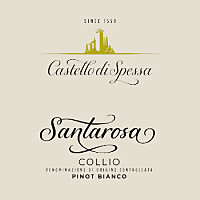
|
|
Collio Pinot Bianco Santarosa 2018 |
|
| Castello di Spessa (Friuli-Venezia Giulia, Italy) | |
 Pinot Bianco Pinot Bianco | |
| Price: € 16.00 | Score: |
 Intense straw yellow and nuances of greenish yellow, very transparent. Intense straw yellow and nuances of greenish yellow, very transparent. Intense, clean, pleasing, refined and elegant, starts with hints of
pear, apple and acacia followed by aromas of peach, citron, white rose,
jasmine, pineapple, elder flower, hawthorn and broom. Intense, clean, pleasing, refined and elegant, starts with hints of
pear, apple and acacia followed by aromas of peach, citron, white rose,
jasmine, pineapple, elder flower, hawthorn and broom.
 Crisp attack and however balanced by alcohol, good body, intense
flavors, agreeable. Crisp attack and however balanced by alcohol, good body, intense
flavors, agreeable.
 Persistent finish with flavors of pear, pineapple and citron. Persistent finish with flavors of pear, pineapple and citron. 5 months in steel tanks. 5 months in steel tanks. |
|
 Crustacean appetizers, Risotto with vegetables, Eggs, Dairy products Crustacean appetizers, Risotto with vegetables, Eggs, Dairy products |
|

|
|
Collio Bianco Molamatta 2015 |
|
| Marco Felluga (Friuli-Venezia Giulia, Italy) | |
 Pinot Bianco, Friulano, Ribolla Gialla Pinot Bianco, Friulano, Ribolla Gialla | |
| Price: € 24.00 | Score: |
 Brilliant golden yellow and nuances of straw yellow, very transparent. Brilliant golden yellow and nuances of straw yellow, very transparent. Intense, clean, pleasing, refined and elegant, starts with hints of
apple, citrus fruits and pineapple followed by aromas of plum, hawthorn,
peach, broom, praline, butter, almond, mineral and vanilla. Intense, clean, pleasing, refined and elegant, starts with hints of
apple, citrus fruits and pineapple followed by aromas of plum, hawthorn,
peach, broom, praline, butter, almond, mineral and vanilla.
 Crisp attack and however balanced by alcohol, good body, intense
flavors, pleasing roundness. Crisp attack and however balanced by alcohol, good body, intense
flavors, pleasing roundness.
 Persistent finish with flavors of apple, plum and pineapple. Persistent finish with flavors of apple, plum and pineapple. Pinot Blanc is fermented in barrique. Pinot Blanc is fermented in barrique. |
|
 Pasta with fish and mushrooms, Broiled fish, Sauteed white meat, Dairy products Pasta with fish and mushrooms, Broiled fish, Sauteed white meat, Dairy products |
|
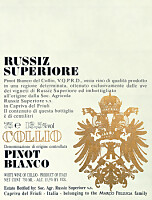
|
|
Collio Pinot Bianco 2018 |
|
| Russiz Superiore (Friuli-Venezia Giulia, Italy) | |
 Pinot Bianco Pinot Bianco | |
| Price: € 22.00 | Score: |
 Brilliant straw yellow and nuances of greenish yellow, very
transparent. Brilliant straw yellow and nuances of greenish yellow, very
transparent.
 Intense, clean, pleasing and refined, starts with hints of apple, pear
and pineapple followed by aromas of hawthorn, banana, citron, peach, plum
and broom. Intense, clean, pleasing and refined, starts with hints of apple, pear
and pineapple followed by aromas of hawthorn, banana, citron, peach, plum
and broom.
 Crisp attack and however balanced by alcohol, good body, intense
flavors, agreeable. Crisp attack and however balanced by alcohol, good body, intense
flavors, agreeable.
 Persistent finish with flavors of apple, peach and pineapple. Persistent finish with flavors of apple, peach and pineapple. 6 months in steel tanks. 6 months in steel tanks. |
|
 Pasta with fish and crustaceans, Sauteed fish and crustaceans, Fried fish Pasta with fish and crustaceans, Sauteed fish and crustaceans, Fried fish |
|
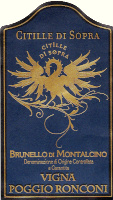
|
|
Brunello di Montalcino Vigna Poggio Ronconi 2014 |
|
| Citille di Sopra (Tuscany, Italy) | |
 Sangiovese Sangiovese | |
| Price: € 40.50 | Score: |
 Intense ruby red and nuances of garnet red, little transparency. Intense ruby red and nuances of garnet red, little transparency. Intense, clean, pleasing, refined and elegant, starts with hints of
black cherry, plum and violet followed by aromas of blueberry, raspberry,
rose, blackberry, cinnamon, tobacco, cocoa, mace, leather, rosemary,
licorice, vanilla and menthol. Intense, clean, pleasing, refined and elegant, starts with hints of
black cherry, plum and violet followed by aromas of blueberry, raspberry,
rose, blackberry, cinnamon, tobacco, cocoa, mace, leather, rosemary,
licorice, vanilla and menthol.
 Tannic attack and however balanced by alcohol, full body, intense
flavors, pleasing crispness. Tannic attack and however balanced by alcohol, full body, intense
flavors, pleasing crispness.
 Very persistent finish with long flavors of black cherry, plum and
blueberry. Very persistent finish with long flavors of black cherry, plum and
blueberry.
 3 years in cask. 3 years in cask. |
|
 Game, Roasted meat, Stewed and braised meat, Hard cheese Game, Roasted meat, Stewed and braised meat, Hard cheese |
|
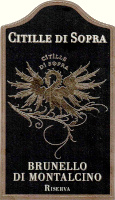
|
|
Brunello di Montalcino Riserva 2012 |
|
| Citille di Sopra (Tuscany, Italy) | |
 Sangiovese Sangiovese | |
| Price: € 56.00 | Score: |
 Intense ruby red and nuances of garnet red, little transparency. Intense ruby red and nuances of garnet red, little transparency. Intense, clean, pleasing, refined and elegant, starts with hints of
plum, black cherry and dried violet followed by aromas of blueberry,
blackberry, cocoa, tobacco, cinnamon, undergrowth, leather, licorice, mace,
vanilla and menthol. Intense, clean, pleasing, refined and elegant, starts with hints of
plum, black cherry and dried violet followed by aromas of blueberry,
blackberry, cocoa, tobacco, cinnamon, undergrowth, leather, licorice, mace,
vanilla and menthol.
 Properly tannic attack and however balanced by alcohol, full body,
intense flavors, agreeable. Properly tannic attack and however balanced by alcohol, full body,
intense flavors, agreeable.
 Very persistent finish with long flavors of plum, black cherry and
blueberry. Very persistent finish with long flavors of plum, black cherry and
blueberry.
 2 years in cask, 1 year in barrique. 2 years in cask, 1 year in barrique. |
|
 Game, Roasted meat, Stewed and braised meat, Hard cheese Game, Roasted meat, Stewed and braised meat, Hard cheese |
|
News |
|
In this section are published news and information about events concerning the world of wine and food. Whoever is interested in publishing this kind of information can send us a mail to our address.
|
AquavitaeReview of Grappa, Distillates and Brandy |
|
|
||||||||||||
Wine Guide ParadeNovember 2019
|
| |||||||
Privacy Policy | |||||||


| Copyright © 2002-2024 Antonello Biancalana, DiWineTaste - All rights reserved |
| All rights reserved under international copyright conventions. No part of this publication and of this WEB site may be
reproduced or utilized in any form or by any means, electronic or mechanical, without permission in writing from DiWineTaste. |